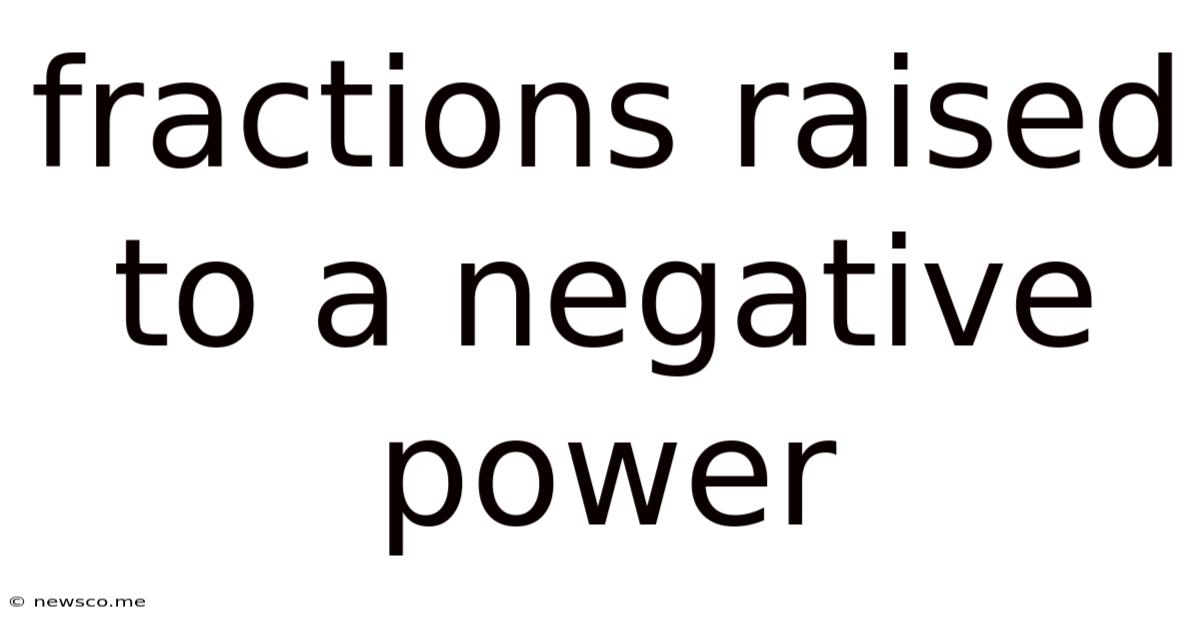Fractions Raised To A Negative Power
News Co
Apr 21, 2025 · 5 min read

Table of Contents
Fractions Raised to a Negative Power: A Comprehensive Guide
Fractions raised to negative powers can seem daunting at first, but with a clear understanding of the underlying principles, they become manageable and even intuitive. This comprehensive guide will dissect the concept, providing you with a solid foundation and practical examples to master this topic. We'll cover everything from the basic rules to advanced applications, ensuring you gain a thorough understanding.
Understanding Negative Exponents
The core concept lies in the reciprocal relationship between positive and negative exponents. Remember the fundamental rule of exponents: a<sup>m</sup> * a<sup>n</sup> = a<sup>m+n</sup>. This rule holds true even when dealing with negative exponents.
Let's consider a simple example: x<sup>3</sup> * x<sup>-3</sup>. Using the rule above, we get x<sup>3 + (-3)</sup> = x<sup>0</sup> = 1. This illustrates that x<sup>-3</sup> is the reciprocal of x<sup>3</sup>, meaning x<sup>-3</sup> = 1/x<sup>3</sup>.
This relationship is the key to understanding fractions raised to negative powers. A fraction raised to a negative power is equal to its reciprocal raised to the positive power.
The Reciprocal: The Heart of Negative Exponents
The reciprocal of a fraction is simply flipping the numerator and the denominator. For instance:
- The reciprocal of ²/₃ is ³/₂
- The reciprocal of ⁵/₁₁ is ¹¹/₅
- The reciprocal of 1/x is x
Therefore, to solve a fraction raised to a negative power, we first find the reciprocal and then raise it to the positive power.
Solving Fractions with Negative Exponents: Step-by-Step Guide
Let's break down the process with a step-by-step guide, using various examples:
Example 1: (²/₃)<sup>-2</sup>
- Find the reciprocal: The reciprocal of ²/₃ is ³/₂.
- Raise to the positive power: Now we have (³/₂)². This means (³/₂) * (³/₂) = ⁹/₄.
- Therefore, (²/₃)<sup>-2</sup> = ⁹/₄
Example 2: (⁵/₁₁)<sup>-1</sup>
- Find the reciprocal: The reciprocal of ⁵/₁₁ is ¹¹/₅.
- Raise to the positive power: (¹¹/₅)¹ = ¹¹/₅.
- Therefore, (⁵/₁₁)<sup>-1</sup> = ¹¹/₅ Notice that raising to the power of -1 simply gives the reciprocal. This is a useful shortcut to remember.
Example 3: (1/x)<sup>-n</sup>
- Find the reciprocal: The reciprocal of 1/x is x.
- Raise to the positive power: We now have x<sup>n</sup>.
- Therefore, (1/x)<sup>-n</sup> = x<sup>n</sup>
Example 4: (3/4x)<sup>-2</sup>
- Find the reciprocal: The reciprocal of 3/4x is 4x/3.
- Raise to the positive power: (4x/3)² = (4x/3) * (4x/3) = 16x²/9
- Therefore, (3/4x)<sup>-2</sup> = 16x²/9 Note how we square both the numerator and denominator.
Dealing with Complex Fractions and Negative Exponents
Things can get a little more complex when dealing with fractions within fractions or more intricate expressions. Let’s explore these scenarios.
Example 5: [(²/₃)/(⁵/₇)]<sup>-3</sup>
- Simplify the inner fraction: First, we simplify the fraction inside the parentheses. To divide fractions, we multiply by the reciprocal: (²/₃) * (⁷/₅) = ¹⁴/₁₅.
- Find the reciprocal: The reciprocal of ¹⁴/₁₅ is ¹⁵/₁₄.
- Raise to the positive power: (¹⁵/₁₄)³ = (¹⁵/₁₄) * (¹⁵/₁₄) * (¹⁵/₁₄) = ³³⁷₅/₂₇₄₄
- Therefore, [(²/₃)/(⁵/₇)]<sup>-3</sup> = ³³⁷₅/₂₇₄₄
Example 6: (x/y)<sup>-n</sup> * (y/z)<sup>n</sup>
- Apply the reciprocal rule: (x/y)<sup>-n</sup> becomes (y/x)<sup>n</sup>.
- Simplify: Now we have (y/x)<sup>n</sup> * (y/z)<sup>n</sup>. Since the exponents are the same, we can combine the fractions: [(y/x) * (y/z)]<sup>n</sup> = (y²/xz)<sup>n</sup> = y<sup>2n</sup>/x<sup>n</sup>z<sup>n</sup>.
- Therefore, (x/y)<sup>-n</sup> * (y/z)<sup>n</sup> = y<sup>2n</sup>/x<sup>n</sup>z<sup>n</sup>
Potential Pitfalls and Common Mistakes
While seemingly straightforward, several common mistakes can trip up students when dealing with fractions and negative exponents:
- Forgetting the Reciprocal: This is the most frequent error. Remember, the negative exponent doesn't just change the sign of the fraction; it reverses the numerator and denominator.
- Incorrectly Applying the Power: When raising a fraction to a power, remember to apply the power to both the numerator and the denominator. A common mistake is only applying the exponent to the numerator or denominator.
- Misunderstanding with Mixed Numbers: Before applying the negative exponent, always convert mixed numbers into improper fractions. For example, convert 2 ½ to ⁵/₂ before proceeding.
- Errors in Simplification: After calculating, always simplify the resulting fraction to its lowest terms.
Practical Applications and Real-World Scenarios
Understanding fractions raised to negative exponents isn't just an academic exercise; it has practical applications in various fields:
- Physics: Negative exponents often appear in formulas related to inverse relationships, such as the inverse square law of gravity.
- Chemistry: In chemical calculations, especially those involving concentrations and dilutions, negative exponents frequently arise.
- Finance: Compound interest calculations sometimes utilize negative exponents when dealing with present values and future values.
- Computer Science: In algorithms and data structures, negative exponents might be encountered in calculations involving growth and decay rates.
Advanced Techniques and Further Exploration
For those looking to delve deeper, exploring these concepts can enhance understanding:
- Logarithms: The connection between exponents and logarithms can provide alternative methods for solving equations involving negative exponents.
- Complex Numbers: Extending the concept to complex numbers adds another layer of complexity and offers exciting opportunities for further mathematical exploration.
- Calculus: Negative exponents play a crucial role in differential and integral calculus.
Conclusion: Mastering Negative Exponents
Mastering the manipulation of fractions raised to negative powers is a crucial skill in mathematics and its various applications. By understanding the concept of the reciprocal and applying the rules consistently, you can confidently tackle even the most complex problems. Remember to practice regularly, review the common pitfalls, and explore the advanced applications to solidify your understanding and build a strong mathematical foundation. With consistent effort, you'll be able to navigate the world of negative exponents with ease and confidence.
Latest Posts
Related Post
Thank you for visiting our website which covers about Fractions Raised To A Negative Power . We hope the information provided has been useful to you. Feel free to contact us if you have any questions or need further assistance. See you next time and don't miss to bookmark.